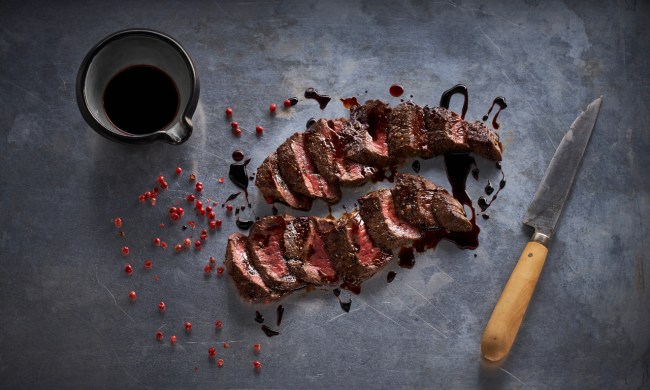If a piece of perfectly grilled filet mignon isn’t already decadent enough for you, there’s an addition that’s guaranteed to satisfy that craving. Enter Steak Oscar; a filet steak topped with fresh crab meat and creamy sauce béarnaise. This is truly a recipe fit for a splurge.
The history of Steak Oscar can actually be traced to Swedish royalty. King Oscar II (1872-1907) was a fan of this surf and turf combination, although the original recipe featured thin breaded veal cutlets instead of beef steak. Sauce béarnaise is already a favorite condiment for filet, and the addition of the sweet crab meat takes the dish to another level. The final addition in most recipes is asparagus spears, which are served whole alongside the steak.
Filet mignon with King Crab Oscar

(From Chef Danny of Quality Bistro)
This unique twist on Steak Oscar comes courtesy of Quality Bistro, a steak-centric brassiere in Midtown Manhattan. Along with a perfectly grilled filet, Quality Bistro uses high-quality King Crab as their shellfish, wrapping it in a delicate crepe before covering it in a rich and creamy sauce béarnaise.
Ingredients:
King Crab Crepe:
- 2 ounces King Crab meat
- 1 cup AP flour
- 2 eggs
- 4 ounces milk
- 4 ounces water
- 2 tablespoons of melted butter
- Pinch of salt
Sauce Béarnaise:
- 1/4 cup white-wine vinegar
- 1 small shallot, peeled and minced
- 1/2 teaspoon freshly cracked black pepper
- 1 tablespoon tarragon leaves, lightly chopped
- 2 egg yolks
- 12 tablespoons unsalted butter, melted
- Kosher salt, to taste lemon juice
Filet Mignon:
- Filet mignon
- Kosher salt
Method:
- Carefully cut open a King Crab leg and remove the meat, lightly pull apart, and season well with lemon zest. Form a 2-ounce puck of the crab meat and set aside. If King Crab is unavailable, feel free to use any high-quality crab meat such as Jumbo lump, Peekytoe crab, or even Lobster in a pinch.
- Heat a 10” nonstick skillet and lightly slick with clarified butter, a natural oil, or a spray of Pam.
- Quickly pour 1/4 cup batter into the center of the skillet, tilting and swirling the pan until batter evenly coats the bottom. Cook until crepe is golden in places on the bottom and edges begin to lift from pan, 1 to 1 1/2 minutes.
- Lift one edge of the crepe with an offset spatula, then use your fingers to gently flip the crepe. Cook on the second side until just set and golden in places on the bottom, about 45 seconds. Slide the crepe onto a paper towel-lined plate.
- Build the crab crepe. On the top of the crab puck, smear a little room-temperature butter — about a tablespoon. Lay out a crepe and place the buttered crab puck butter side down in the center of the crepe. Carefully fold the crepe around the puck to make a neat little package.
- For sauce béarnaise. Put the vinegar, shallots, black pepper and the tarragon leaves into a small saucepan and set over medium heat. Bring just to a boil, and then reduce heat to a simmer until there are only a few tablespoons of liquid left, approximately 5 minutes. Remove from heat and set aside to cool.
- Fill a small saucepan with an inch or two of water and set over medium-high heat to boil.
- Put the cooled shallot-and-tarragon mixture into a metal mixing bowl along with a tablespoon of water and the egg yolks, then whisk to combine.
- Turn the heat under the saucepan of water down to its lowest setting, and put the bowl on top of the pan, making sure that it does not touch the water directly. Continue to whisk the yolks until they start to thicken, approximately 6 minutes. The volume of the yolks will double in volume.
- Slowly add the butter, a tablespoon or two at a time, whisking slowly to combine and emulsify.
- Remove the bowl from the pan occasionally, so as not to overcook the eggs, and taste the sauce. Season with salt. If the flavor is not sharp enough, add a splash of lemon juice. Adjust the sauce. If its too thick just stir in a splash of hot water. Hold the finished sauce in a warm place.
- Season and cook your fillet as desired.
- After cooking and while the fillet is resting, spread a little butter down on a sheet tray and set the crab crepe package on top of the butter and heat until warmed throughout, about 3-4 minutes. Plate the fillet and the Crab crepe, and serve the sauce on the side.



